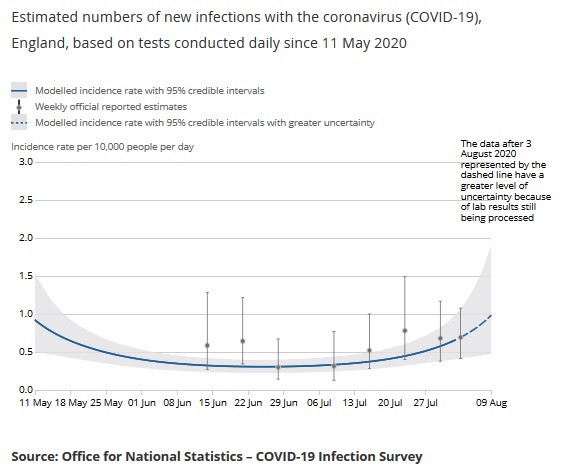- The official 'Confirmed New Cases' reported daily by PHE from NHS Test and Trace, and used to be presented in the Downing Street press briefings, need to be multiplied by at least 4 or 5 to get a realistic number. That is because not all positive cases are tested, asymptomatic cases are overlooked, and swabbing is prone to give false negatives
- The King's College London ZOE data is also understated, probably by a factor of around 2, as it only covers people rich enough to have a smartphone, and who have downloaded the app
- The ONS Office for National Statistics' Infection Survey reports weekly using random testing, which therefore picks up all people who have become infected within a day or two of infection
The ONS Infection Survey has a major advantage over the other two, in that it potentially picks up the full range of people infected. However whist it picks up new cases more rapidly, it also lags a little by reporting weekly . For example the report on Friday 14 August was for the week to Sunday 9th.
But the Survey has suffered from one major problem. The sample size has been too small, so 95% confidence intervals have been too wide, as denoted by the blue shading in this graph taken from the latest report of 14 August. Regional trends have been unreliable.
When I reviewed the different data sources in detail against the standards common in business, back on 4 August, I said "Let’s hope the sampling is substantially increased."
So it has happened. Today it has been announced that the ONS Infection Survey "will test 150,000 people a fortnight in England by October, up from 28,000 now".
As Matt Hancock, the Health Secretary said this morning "it would help the government with its 'biggest challenge', which was finding people who were asymptomatic but could still pass the virus on."
This increase in testing is great news, which I should imagine will give an excellent national picture of infection level and trends, and a good regional picture. Whether that's enough to give realistic results for individual towns and communities I doubt. We'll have to wait to see what level of geographical granularity and confidence levels are presented later in the year. A further increase will I suspect be welcomed.
In the meantime, we'll need to make the most of the data we've got. I'll be reviewing and comparing the latest data when the weeklies are reported at the end of this week, Friday 21 August.







No comments:
Post a Comment